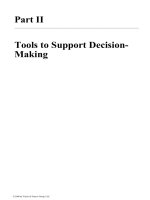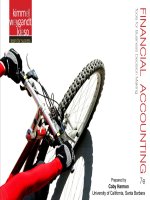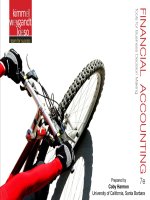Financial accounting 8e tool for busniess decision making chapter 12
Bạn đang xem bản rút gọn của tài liệu. Xem và tải ngay bản đầy đủ của tài liệu tại đây (9.3 MB, 85 trang )
12-1
12
Statement of Cash Flows
Kimmel ● Weygandt ● Kieso
Financial Accounting, Eighth Edition
12-2
CHAPTER OUTLINE
LEARNING OBJECTIVES
12-3
1
Discuss the usefulness and format of the statement of cash flows.
2
Prepare a statement of cash flows using the indirect method.
3
Use the statement of cash flows to evaluate a company.
LEARNING OBJECTIVE
1
Discuss the usefulness and format of the statement of cash flows.
USEFULNESS OF THE STATEMENT OF CASH FLOWS
Provides information to help assess:
12-4
1.
Entity’s ability to generate future cash flows.
2.
Entity’s ability to pay dividends and meet obligations.
3.
Reasons for difference between net income and net cash provided (used) by operating activities.
4.
Cash investing and financing transactions during the period.
LO 1
CLASSIFICATION OF CASH FLOWS
Investing Activities
Financing Activities
Operating Activities
Income Statement Items
Changes in Investments
Changes in Long-Term
and Long-Term Assets
Liabilities and
Stockholders’ Equity
12-5
LO 1
CLASSIFICATION OF CASH FLOWS
Operating activities—Income statement items
Cash inflows:
ILLUSTRATION 12-1
Typical receipt and payment classifications
From sale of goods or services.
From interest received and dividends received.
Cash outflows:
To suppliers for inventory.
To employees for wages.
To government for taxes.
To lenders for interest.
To others for expenses.
12-6
LO 1
CLASSIFICATION OF CASH FLOWS
Investing activities—Changes in investments and long-term assets
Cash inflows:
ILLUSTRATION 12-1
Typical receipt and payment classifications
From sale of property, plant, and equipment.
From sale of investments in debt or equity securities of other
entities.
From collection of principal on loans to other entities.
Cash outflows:
To purchase property, plant, and equipment.
To purchase investments in debt or equity securities of other
entities.
To make loans to other entities.
12-7
LO 1
CLASSIFICATION OF CASH FLOWS
Financing activities—Changes in long-term liabilities and stockholders’ equity
Cash inflows:
ILLUSTRATION 12-1
Typical receipt and payment classifications
From sale of common stock.
From issuance of debt (bonds and notes).
Cash outflows:
To stockholders as dividends.
To redeem long-term debt or reacquire
capital stock (treasury stock).
12-8
LO 1
SIGNIFICANT NONCASH ACTIVITIES
1.
Direct issuance of common stock to purchase assets.
2.
Conversion of bonds into common stock.
3.
Issuance of debt to purchase assets.
4.
Exchanges of plant assets.
Companies report noncash activities in either a
12-9
separate schedule (bottom of the statement) or
separate note to the financial statements.
LO 1
ACCOUNTING ACROSS THE ORGANIZATION
Net What?
12-10
LO 1
FORMAT OF THE STATEMENT OF CASH FLOWS
Order of Presentation:
Direct Method
1.
12-11
Operating activities.
Indirect Method
2.
Investing activities.
3.
Financing activities.
LO 1
ILLUSTRATION 12-2
Format of statement of cash flows
12-12
LO 1
DO IT!
1
Cash Flow Activities
Illustration: Classify each of these transactions by type of cash flow activity.
1.
Issued 100,000 shares of $5 par value common stock for $800,000 cash.
2.
Borrowed $200,000 from Castle Bank, signing a 5-year note bearing 8% interest.
3.
Purchased two semi-trailer trucks for $170,000 cash.
4.
Paid employees $12,000 for salaries and wages.
5.
Collected $20,000 cash for services performed.
Financing
Financing
Investing
Operating
Operating
12-13
LO 1
LEARNING OBJECTIVE
2
Prepare a statement of cash flows using the indirect method.
Three sources of information:
12-14
1.
Comparative balance sheets
2.
Current income statement
3.
Additional information
LO 2
Preparing the Statement of Cash Flows
Three Major Steps:
ILLUSTRATION 12-3
Three major steps in preparing
the statement of cash flows
12-15
LO 2
Preparing the Statement of Cash Flows
Three Major Steps:
ILLUSTRATION 12-3
Three major steps in preparing
the statement of cash flows
12-16
LO 2
Preparing the Statement of Cash Flows
Three Major Steps:
ILLUSTRATION 12-3
Three major steps in preparing
the statement of cash flows
12-17
LO 2
INDIRECT AND DIRECT METHODS
Companies favor the indirect method for two reasons:
12-18
1.
Easier and less costly to prepare.
2.
Focuses on differences between net income and net cash flow from operating activities.
LO 2
INDIRECT METHOD
ILLUSTRATION 12-4
Comparative balance sheets, income statement, and additional information for Computer
Services Company
12-19
LO 2
ILLUSTRATION 12-4
Comparative balance sheets, income statement, and additional information for Computer
Services Company
12-20
LO 2
Change in
2017
2016
Account Balance
Additional information for 2017:
1.
2.
3.
4.
5.
6.
12-21
ILLUSTRATION 12-4
Depreciation expense was comprised of $6,000 for building and $3,000 for equipment.
The company sold equipment with a book value of $7,000 (cost $8,000, less accumulated depreciation $1,000) for $4,000 cash.
Issued $110,000 of long-term bonds in direct exchange for land.
A building costing $120,000 was purchased for cash. Equipment costing $25,000 was also purchased for cash.
Issued common stock for $20,000 cash.
The company declared and paid a $29,000 cash dividend.
LO 2
STEP 1: OPERATING ACTIVITIES
DETERMINE NET CASH PROVIDED/USED BY OPERATING ACTIVITIES BY
CONVERTING NET INCOME FROM ACCRUAL BASIS TO CASH BASIS.
Common adjustments to Net Income (Loss):
12-22
Add back noncash expenses (depreciation, amortization, or depletion expense).
Deduct gains and add losses.
Analyze changes to noncash current asset and current liability accounts.
LO 2
STEP 1: OPERATING ACTIVITIES
Review Question
Which is an example of a cash flow from an operating activity?
12-23
a.
Payment of cash to lenders for interest.
b.
Receipt of cash from the sale of capital stock.
c.
Payment of cash dividends to the company’s stockholders.
d.
None of the above.
LO 2
STEP 1: OPERATING ACTIVITIES
Depreciation Expense
Although depreciation expense reduces net income, it does not reduce cash. The company must add it
back to net income.
ILLUSTRATION 12-6
Adjustment for depreciation
12-24
LO 2
STEP 1: OPERATING ACTIVITIES
Loss on Disposal of Plant Assets
Companies report as a source of cash in the investing activities section the actual amount of cash
received from the sale.
12-25
Any loss on disposal is added to net income in the operating section.
Any gain on disposal is deducted from net income in the operating section.
LO 2









